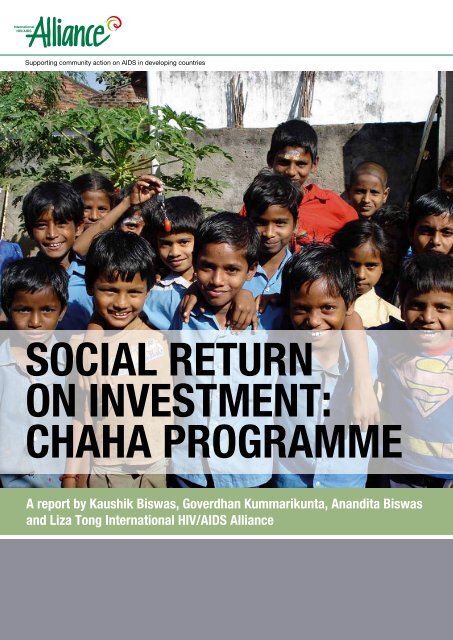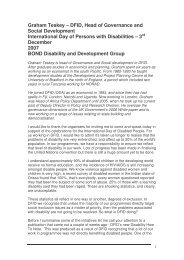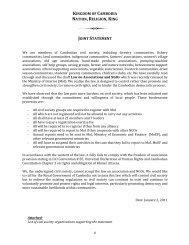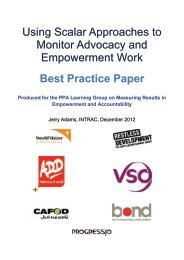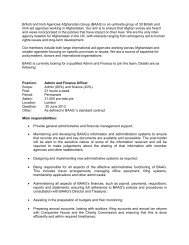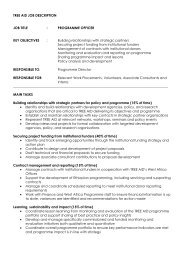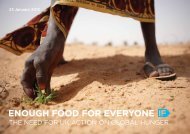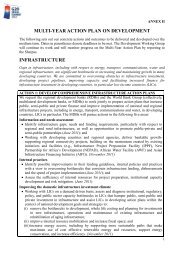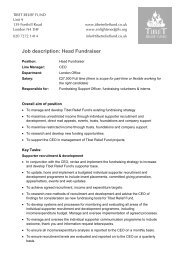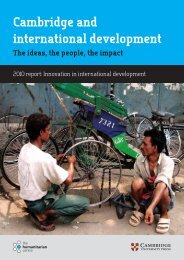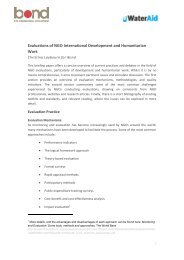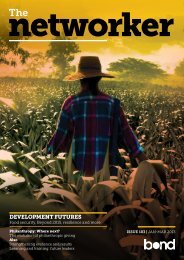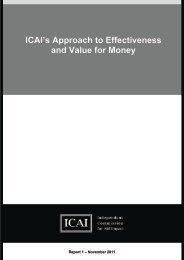Social RetuRn on inveStment: cHaHa PRogRamme - Bond
Social RetuRn on inveStment: cHaHa PRogRamme - Bond
Social RetuRn on inveStment: cHaHa PRogRamme - Bond
You also want an ePaper? Increase the reach of your titles
YUMPU automatically turns print PDFs into web optimized ePapers that Google loves.
1 C<strong>on</strong>tentsIntroducti<strong>on</strong> and background 3Secti<strong>on</strong> 1: Alliance India and the CHAHA Programme 4Secti<strong>on</strong> 2: SROI methodology 6Phase 1: Setting the boundaries of the study 6Phase 2: Stakeholder c<strong>on</strong>sultati<strong>on</strong> and outcomes map 8Phase 3 and 4: Data collecti<strong>on</strong> and the ec<strong>on</strong>omic model 13Phase 5: SROI ratio and benefits breakdown 20Phase 6: Recommendati<strong>on</strong>s 26Annex 1: Stakeholder c<strong>on</strong>sultati<strong>on</strong>s 28Cover image: Children’s group run by Vasavya Mahila Mandali in Andhra Pradesh, India. © The AllianceAbove: CHAHA nutriti<strong>on</strong>al programme. © Gide<strong>on</strong> Mendel for the Alliance<str<strong>on</strong>g>Social</str<strong>on</strong>g> Return <strong>on</strong> Investment: CHAHA Programme >> report 2010
2Acr<strong>on</strong>ymsAIDSARTARVCBOCMISCSOCTXHIVIRM&ENGONVPPMTCTPPPSSRSRSROISTIUNAIDSUSAIDAcquired immunodeficiency syndromeAntiretroviral therapyAntiretroviralCommunity-based organisati<strong>on</strong>Computerised management informati<strong>on</strong> systemCivil society organisati<strong>on</strong>Co-trimoxazoleHuman immunodeficiency virusIndian rupeesM<strong>on</strong>itoring and evaluati<strong>on</strong>N<strong>on</strong>-governmental organisati<strong>on</strong>sNet value percentagePreventi<strong>on</strong> of mother-to-child transmissi<strong>on</strong>Purchasing power paritySub-sub RecipientSub-Recipient<str<strong>on</strong>g>Social</str<strong>on</strong>g> return <strong>on</strong> investmentSexually transmitted infecti<strong>on</strong>Joint United Nati<strong>on</strong>s Programme <strong>on</strong> HIV/AIDSUnited States Agency for Internati<strong>on</strong>al Development<str<strong>on</strong>g>Social</str<strong>on</strong>g> Return <strong>on</strong> Investment: CHAHA Programme >> report 2010
3Introducti<strong>on</strong> and backgroundIn resp<strong>on</strong>se to the growing urgency to effectively dem<strong>on</strong>strate aid accountability, through valuefor m<strong>on</strong>ey and attenti<strong>on</strong> to cost efficiency and effectiveness, for the latter the Alliance is adaptingand piloting a methodology based <strong>on</strong> measuring and valuing social and health outcomes againstinvestment. The social return <strong>on</strong> investment (SROI) is <strong>on</strong>e of a number of methods that hasbeen proposed as suitable for simplificati<strong>on</strong> and adaptati<strong>on</strong> and to be applied within a LinkingOrganisati<strong>on</strong> to test the value for m<strong>on</strong>ey of specific programmes or programme comp<strong>on</strong>ents.DIAGRAM 1:SROI compares‘m<strong>on</strong>etised’outcomes withinvestmentsResources and investmentsInputsOutputsServices and wider outcomes<str<strong>on</strong>g>Social</str<strong>on</strong>g> • Health • Ec<strong>on</strong>omicSROI is a framework to measure and account for the value created by a programme or seriesof initiatives, bey<strong>on</strong>d financial value. It incorporates social, health, envir<strong>on</strong>mental and ec<strong>on</strong>omiccosts and benefits. It is of particular relevance to the Alliance as our programming results insocial, health and ec<strong>on</strong>omic outcomes, for which the Alliance has systems to describe and track,yet, so far, there is no satisfactory way of valuing or allocating a m<strong>on</strong>etary value to. This methodis a participatory, beneficiary-led approach which uses financial values defined by programmebeneficiaries to represent social, health and ec<strong>on</strong>omic outcomes, thus enabling a ratio of benefitsto costs to be calculated. For example, a ratio of 1:4 indicates that an investment of $1 delivers $4of social value.In additi<strong>on</strong> to testing the appropriateness of the method, the study assessed to what extent SROIcould be used as a management tool to decide which programme comp<strong>on</strong>ents/activities andinputs are more effective at delivering which outcome, and c<strong>on</strong>versely which derive little ‘outcomevalue’, thereby enabling a re-planning of programme strategy or activities in order to maximise theoutcomes for end beneficiaries.SROI is not without it’s challenges, in the absence of standards and a robust method of auditingan organisati<strong>on</strong>’s ‘claims’ to the value it creates, ratios of return can be easily dismissed. We haveattempted to detail the assumpti<strong>on</strong>s, the processes, the measurement of outcomes in order tofully document how figures were calculated so that independent readers can make a judgement<strong>on</strong> the credibility of the assumpti<strong>on</strong>s and by extensi<strong>on</strong> study c<strong>on</strong>clusi<strong>on</strong>s.This pilot study assessed the SROI of the CHAHA programme – a child-centred home- andcommunity-based case and support initiative and a 3½ year Global Fund programme –implemented by Alliance India and her partners.More than 70 beneficiaries were c<strong>on</strong>sulted and a range of outputs and outcomes were identifiedfrom their perspective. Based <strong>on</strong> this work in Maharastra State it appears that every $1 invested inCHAHA from 2008 to 2010 generated $4 of social, health and financial value. More than half (52%)of this value accrued to parents and caregivers with just under half (45%) benefitting childrendirectly. Most value was created through improvement in livelihood status, improved health statusof the child, other children having better income prospects and improved educati<strong>on</strong>al attendanceand status. Less value was created through avoidance of family crisis, improved health status ofthe family and improved family care. It is anticipated that this informati<strong>on</strong> may be useful to CHAHAand the Alliance in making management decisi<strong>on</strong>s, e.g. <strong>on</strong> where to focus support.<str<strong>on</strong>g>Social</str<strong>on</strong>g> Return <strong>on</strong> Investment: CHAHA Programme >> report 2010
4SECTION 1: Alliance India and the CHAHA ProgrammeEstablished in 1999 Alliance India comprises of a secretariat in New Delhi, five lead partnerorganisati<strong>on</strong>s and their networks of over 100 community-based organisati<strong>on</strong>s (CBOs) and n<strong>on</strong>governmentalorganisati<strong>on</strong>s (NGOs) across Andhra Pradesh, Tamil Nadu, Maharashtra andManipur. CHAHA (meaning ‘wish’ or ‘hope’) is Alliance India’s resp<strong>on</strong>se to the needs of childrenliving with and affected by HIV. It receives funding from Round 6 of the Global Fund and wasdesigned as a five-year expanded child-centered, home-based care and support programme, witha target of 64,000 children. The three main approaches for providing direct and indirect services tochildren living with or affected by HIV were to:1. create a supportive envir<strong>on</strong>ment through community mobilisati<strong>on</strong> in all settings (health, socialand legal) for HIV-related stigma reducti<strong>on</strong>2. strengthen and build the capacity of NGOs and CBOs3. strengthen informati<strong>on</strong> systems and c<strong>on</strong>duct operati<strong>on</strong>s research.CHAHA works through it’s outreach workers to provide improved access to healthcare andimprove health seeking behaviour of affected children and families. Referrals and linkages arecreated between families and healthcare systems, such as HIV testing, opportunistic infecti<strong>on</strong>s(OI) prophylaxis and management, antireroviral treatment (ART) and sexual and reproductivehealth (see Diagram 2).An illustrati<strong>on</strong> of the areas of work CHAHA has been involved with that form part of this SROI aredescribed briefly below.Nutriti<strong>on</strong>al supportCHAHA provides referrals and linkages to families of children living with and affected by HIVto government schemes, such as the Integrated Child Development Scheme. Direct nutriti<strong>on</strong>alsupport is also provided, as well as nutriti<strong>on</strong>al counselling and food dem<strong>on</strong>strati<strong>on</strong>s.Educati<strong>on</strong>al support and vocati<strong>on</strong>al skills development for youthCHAHA facilitates the support of children living with HIV to return to school to complete theireducati<strong>on</strong>, by creating a positive learning envir<strong>on</strong>ment for them through sensitisati<strong>on</strong> work withdistrict and school authorities, advocacy with schools and community around the right of childrenliving with HIV to access educati<strong>on</strong>, and direct support in the provisi<strong>on</strong> of books, uniforms andother educati<strong>on</strong>al material, counselling individual children and their families. Older children livingwith and affected by HIV are supported in vocati<strong>on</strong>al training.Psychosocial supportCHAHA provides counselling for children living with and affected by HIV and their families through<strong>on</strong>e-to-<strong>on</strong>e interacti<strong>on</strong> and home visits.Household supportIn times of crisis CHAHA provides emergency support to families of children living with andaffected by HIV in the form of funds for hospitalisati<strong>on</strong>, travel for medical emergencies, treatment,diagnosis, water filters, bed nets and emergency housing material.Income-generati<strong>on</strong>This support targets families of children living with and affected by HIV and older children livingwith HIV that are able to run an income-generating scheme. Grants and skills building support areprovided. Typical businesses would be tea selling, vegetable vending, petty shops, tailoring, etc.<str<strong>on</strong>g>Social</str<strong>on</strong>g> Return <strong>on</strong> Investment: CHAHA Programme >> report 2010
6SECTION 2: SROI methodologyThe Alliance India and Alliance secretariat planned and c<strong>on</strong>ducted a SROI study in October 2010.The purpose of the study was to develop and test a simplified methodology to value and quantifysocial and health returns of a typical Alliance care and support programme in order to determine aratio for return <strong>on</strong> investment for a) understanding cost effectiveness b) applicati<strong>on</strong> in programmedecisi<strong>on</strong> making.As this was the first study of this nature to be c<strong>on</strong>ducted by the Alliance (and to our knowledge inIndia), it was c<strong>on</strong>sidered useful to document the process as a step-by-step approach.n Phase 1: Setting the boundaries of the studyn Phase 2: The stakeholder c<strong>on</strong>sultati<strong>on</strong> and outcomes mapn Phase 3: Data collecti<strong>on</strong> (for outcomes)n Phase 4: Developing the ec<strong>on</strong>omic modeln Phase 5: The SROI ratio and benefits breakdownn Phase 6: Programme recommendati<strong>on</strong>sPhase 1: Setting the boundaries of the studyAlliance India is the civil society Principle Recipient for CHAHA. It has 10 Sub-Recipientimplementing partners in the states of Andhra Pradesh, Tamil Nadu, Maharashtra and Manipur.The period over which the SROI was calculated is from 2007 to October 2010. This includesinputs over the three-year period.The SROI covered two states, Maharastra and Andhara Pradesh. It was c<strong>on</strong>sidered that giventhe study’s limitati<strong>on</strong>s with time and resources, two of the four CHAHA states would give a goodindicati<strong>on</strong> of the range of return that could be expected of the programme for our purposes. (Note:it is acknowledged that the state variances in cultural c<strong>on</strong>text, costs and governance may resultin a broader range of SROI and in the interests of a full SROI study for the whole of the CHAHAprogramme it would be preferable to c<strong>on</strong>duct the study in all four states.)Organisati<strong>on</strong>s taking part included the Internati<strong>on</strong>al HIV/AIDS Alliance, Alliance India, LEPRA,NMP+, Gram, WORD, RIDES and PEACE.Background documents included:CHAHA programme annual reportsCHAHA end of year financial reportsCHAHA baseline and midline study, quantitative findingsLearning from change MSC report of CHAHACHAHA midline assessmentCHAHA computerised management informati<strong>on</strong> system (CMIS)<str<strong>on</strong>g>Social</str<strong>on</strong>g> Return <strong>on</strong> Investment: CHAHA Programme >> report 2010
7Limitati<strong>on</strong>s of the studyThe following describes the c<strong>on</strong>straints and how the study team attempted to address themwhere possible:1. Limited timeframe to execute the stakeholder c<strong>on</strong>sultati<strong>on</strong>. Ideally the study wouldhave been c<strong>on</strong>ducted over a l<strong>on</strong>ger period of time, a field c<strong>on</strong>sultati<strong>on</strong> lasting <strong>on</strong>e weekwas shortened due to public holidays occurring at the same time, however it was possibleto combine stakeholder groups thereby shortening the actual time required to repeat theexercise with numerous groups.2. With SROI being a new c<strong>on</strong>cept in India, it was difficult to identify the sec<strong>on</strong>darydata sources. This is the <strong>on</strong>ly example of a SROI study of this type being c<strong>on</strong>ducted inIndia (at least to our knowledge and attempts to refer to other studies), hence there wasno precedent to base our experience <strong>on</strong>, other than UK-based examples. Alliance Indiahas very good, robust m<strong>on</strong>itoring systems and had c<strong>on</strong>ducted a midline survey whichcovered a number of the outcome indicators of interest.3. Difficulty in facilitating the primary stakeholders, who tended to relate themselvesto the situati<strong>on</strong>s they came across or were familiar with (which at times made itdifficult for them to express their experiences as ‘outcomes’ per se). This was even moredifficult with children. Given the nature of the CHAHA programme – and keeping to thefundamental principles of SROI – c<strong>on</strong>sultati<strong>on</strong> with ultimate beneficiaries, c<strong>on</strong>ducting thediscussi<strong>on</strong>s with children was challenging, however a simplified workshop approach wasdeveloped and refined as the team gained more experience.4. The attributi<strong>on</strong> value range (i.e. of the programme to outcomes experienced) has beencollated from the primary stakeholders, as well as knowledge of other initiatives, projectsand stakeholders operating in the area. There was high variati<strong>on</strong> in these values. Thusthe issue of subjectivity arose. The study team took the approach to use the average ofvalues discussed for the calculati<strong>on</strong>.5. Not all value created for the state has been reflected – for example, the additi<strong>on</strong>altax revenue created from people in employment, (in India the 10% tax rate starts whenearnings are over $300 a m<strong>on</strong>th).6. The outcome incidence value was determined through a mixture of beneficiary andNGO c<strong>on</strong>sultati<strong>on</strong>. Midline survey values against indicators ‘similar’ but not exactlythe same as those expressed by participants were referred to. It is acknowledged thatassumpti<strong>on</strong>s had to be made to determine approximate values here. See the later secti<strong>on</strong><strong>on</strong> the ec<strong>on</strong>omic model.7. The deadweight or counterfactual – the measurement of the amount of outcome thatwould have happened in the absence of CHAHA activity – was difficult to estimate as apercentage. Reference to published sec<strong>on</strong>dary country statistics was difficult to find andwe had to rely <strong>on</strong> programmatic staff estimates, and c<strong>on</strong>sultati<strong>on</strong> with stakeholders. As anestimate we have used a 10% deadweight factor across all of the outcome areas.8. Due to the lack of a timeframe, some stakeholders could not be the part ofstakeholder c<strong>on</strong>sultati<strong>on</strong>, e.g. Government, State AIDS C<strong>on</strong>trol Societies, other publichealth departments. These stakeholders, whilst important were not c<strong>on</strong>sidered essentialfor the study as they were not ultimate beneficiaries.9. This tests the potential sustainability of aspects of the programme, or otherwise. Again thestudy team took a c<strong>on</strong>servative approach to drop off 1 in c<strong>on</strong>sultati<strong>on</strong> with technical staffof the programme.1. Drop off determines benefit period looks at how l<strong>on</strong>g the outcomes last for and is a measure of sustainability of the programme’sinvestment. The drop off is a robust measure that takes into account the fact that outcomes may revert over time and that the CHAHAprogramme cannot take credit for them lasting for the full benefit period True benefit period and drop off values are <strong>on</strong>ly available throughl<strong>on</strong>gitudinal surveys.<str<strong>on</strong>g>Social</str<strong>on</strong>g> Return <strong>on</strong> Investment: CHAHA Programme >> report 2010
8 Phase 2: Stakeholder c<strong>on</strong>sultati<strong>on</strong> and outcomes mapBeneficiaries of the programme from two states were c<strong>on</strong>sulted over a period of three days.During this time two parents’ and caregivers’ groups and two children’s groups took part in a fourhourfacilitated discussi<strong>on</strong> <strong>on</strong> the programme. A total of 72 ultimate beneficiaries were c<strong>on</strong>sultedand 20 to 25 NGO staff.A fairly structured approach was followed: (See Annex 1 for a full descripti<strong>on</strong> of the process as aworkshop.)1. Building a map of project stakeholders2. Identifying activities, outputs and outcomes and creating an outcome map3. Talking about other projects/activities in the area (attributi<strong>on</strong>, deadweight)4. Talking about outcome incidence5. Indicators for measuring outcomes6. Putting a value <strong>on</strong> project outcomesThe following stakeholders were identified before and during the community c<strong>on</strong>sultati<strong>on</strong>. Somehave been identified as significant for inclusi<strong>on</strong> into the analysis, i.e. costs/resources/investmentprovided by them, or as ultimate beneficiaries, others we have listed as discussed at thec<strong>on</strong>sultati<strong>on</strong>s. Table 1 highlights the rati<strong>on</strong>ale for their inclusi<strong>on</strong> or exclusi<strong>on</strong> in the analysis.Table 1: Project stakeholdersStakeholder Involvement in CHAHA Rati<strong>on</strong>ale Method of engagement NumberengagedChildren over 10years oldUltimate beneficiaries of theprogrammeIncludedSurveyCommunity c<strong>on</strong>sultati<strong>on</strong>1,63036Parents andcaregiversVery direct beneficiaries of theprogrammeIncludedSurveyCommunity c<strong>on</strong>sultati<strong>on</strong>1,32336NGO staffVocati<strong>on</strong>al training, incomegeneratingprogramme support,legal, counselling, educati<strong>on</strong>alsupportNot included (theyimplement the programme)Community c<strong>on</strong>sultati<strong>on</strong>Children under 10years oldVery direct beneficiaries of theprogrammeIncludedSurvey through aquesti<strong>on</strong>naire applied tocaregivers <strong>on</strong> their behalfWomen-headedhouseholdsVery direct beneficiaries of theprogrammeIncludedSurveyCommunity c<strong>on</strong>sultati<strong>on</strong>TeachersNot included, did notc<strong>on</strong>sider that they couldbe categorised as ultimatebeneficiaries (they are ineffect an educati<strong>on</strong> serviceprovider<str<strong>on</strong>g>Social</str<strong>on</strong>g> Return <strong>on</strong> Investment: CHAHA Programme >> report 2010
9Table 1: Project stakeholders (c<strong>on</strong>tinued)Stakeholder Involvement in CHAHA Rati<strong>on</strong>ale Method of engagement NumberengagedHouseholds Included as a family unit Survey 1,330Relatives/friendsof householdsaffectedGovernmentservices:Grmapanchayat(legal services),Angawadi(nutriti<strong>on</strong>alschemes),ANM (healthinformati<strong>on</strong>),Governmenthospital, ICTC(counselling andtesting)ART centreLocal leaderLegal documents, nutriti<strong>on</strong>al andhealth support, free treatment forOIFree ART, CD4 test, CTX,counsellingSupport for reducing stigma anddiscriminati<strong>on</strong>Not included(immediate relatives livingin a beneficiary householdwere included, howevermore distant relativeswere not c<strong>on</strong>sidered toexperience such a directbenefit)State included as abeneficiary for theco-trimoxazole (CTX)prophylaxis comp<strong>on</strong>ent, aswe wanted to explore theimpact to the state of CTX<strong>on</strong> child health outcomesNot included (a serviceprovider as opposed toreceiving benefits directly– however there would besome cost saving, i.e. stafftime, counsellors similar tothe above)Not included (notc<strong>on</strong>sidered to experience adirect benefit)The outcomes mapThe theory of change, used to base the analysis <strong>on</strong>, is that through the provisi<strong>on</strong> of multiple areasof direct and indirect support for children living with HIV and their families numerous outcomesare generated under the themes of physical and mental health, ec<strong>on</strong>omic status and incomegenerating/earningpotential and lifespan and ability of families to cope in crisis. This map wasdeveloped by the ultimate beneficiaries, during the c<strong>on</strong>sultati<strong>on</strong>, and a separate qualitativeCHAHA study Stories of Significance: Understanding Change Through Community Voices’ (March2010) termed the outcome map (see Diagram 3).<str<strong>on</strong>g>Social</str<strong>on</strong>g> Return <strong>on</strong> Investment: CHAHA Programme >> report 2010
10 DIAGRAM 3: The outcomes mapTheoretical modelInputsActivitiesOutputsOutcomesImpactsi.e. time,grants, staff,volunteersCHAHA projectactivitiesExperiencedby participantsand otherstakeholdersChangesexperienced/observed byparticipantsBig picturechanges for awider group ofpeopleActual modelInputsStaff at SSR, SRLogisticsFunding for direct andindirect supportFunding for medicalemergency supportFunding for developinglinkages and advocacyCHAHA activitiesNutriti<strong>on</strong>al supportHousehold supportEducati<strong>on</strong>al trainingOutputs (experiencedby participants and otherstakeholders)Receipt of food rati<strong>on</strong>sReceipt of nutriti<strong>on</strong>aleducati<strong>on</strong>Receipt of emergencyhelp – water filters, bednets, roofing sheets,cost of funeralOutcomes(experienced/observed byparticipants)Improved physicalhealth of children andparentsAvoidance of familycrisis – family able tocopeVocati<strong>on</strong>al trainingReceipt of <strong>on</strong>goingschooling throughfees payment, books,uniform, support fromoutreach worker forbetter attendanceImproved educati<strong>on</strong>altraining and statusIncome-generatingHealth, OICounselling, mentalhealthStigma sensitisati<strong>on</strong>Receipt of vocati<strong>on</strong>altraining, skills buildingand mentoringReceipt of incomegeneratingproject startup support, grants andtrainingReferred and linked tohealth services and CTXReferred and linked tocounselling servicesReceived familycounsellingImproved skillsand wage earningopportunitiesImproved livelihoodgenerati<strong>on</strong>Increase in lifespan ofadults and children,improved ARTadherenceReceived anti-stigmasensitisati<strong>on</strong>Improved mental healthof parents, caregiversand childrenReducti<strong>on</strong> in stigmaexperienced<str<strong>on</strong>g>Social</str<strong>on</strong>g> Return <strong>on</strong> Investment: CHAHA Programme >> report 2010
11Change from the perspective of the CHAHA parents and caregiversThe following is a series of short case studies or perspectives captured from communityc<strong>on</strong>sultati<strong>on</strong>s.Nutriti<strong>on</strong>al support: “Because of nutriti<strong>on</strong>al support we see improved children’s health andreduced OI episodes and ultimately reduced visits for treatment and now we are saving theexpenditure of travelling and treatment, simultaneously child is attending school regularly.”Nutriti<strong>on</strong>alsupportG.K. is a 15 year old boy living with HIV, studying in Standard 8. He was identified by a CHAHAoutreach worker and registered in September 2007. Both his parents had died of AIDS. Heis cared for by an elder sister who is married to his maternal uncle. Since registering <strong>on</strong> theCHAHA programme G.K. is now <strong>on</strong> ART. He has also been receiving nutriti<strong>on</strong>al support everyquarter and is included in the nutriti<strong>on</strong>al m<strong>on</strong>itoring. He gets educati<strong>on</strong>al and OI support. He isnow able to attend school regularly and is achieving really good grades. The counselling hasmade him feel really positive about himself and his future, and has also helped him to take themedicine regularly.Household support: “Household support has helped us a lot because in an emergency thissupport has helped us fulfil our basic needs and helped us to survive.”Educati<strong>on</strong>al support: “My children are now attending school regularly and have the visi<strong>on</strong> ofbeing some<strong>on</strong>e like a teacher or in the police in the future. This educati<strong>on</strong>al support will help themto sustain their lives.”Income-generating and vocati<strong>on</strong>al training: “This has helped sustain our family and increasedincome, before that we were going to work <strong>on</strong> daily wages and could earn <strong>on</strong>ly 30 to 40 IRs, nowwe are earning 100 to 150 IRs a day.”Referral and linkages – OI support and improved health seeking behaviour: “We have curedopportunistic infecti<strong>on</strong>s <strong>on</strong> time because we are now going to get health treatment, we knowwhere to get it”“Because of the referrals we got from CHAHA we are attending Government hospitals and gettingfree treatment and Co-trimoxazole medicine for children.”Referral and linkages – ART: “Before c<strong>on</strong>tacting CHAHA we were not aware about free ART fromthe Government ART Centre. After registrati<strong>on</strong> in CHAHA, the outreach worker took us to the ARTCentre, initiated free ART medicine and counselled us <strong>on</strong> the importance of adherence. Beforethat we took very expensive treatment around 4000 to 5000 IRs per m<strong>on</strong>th from a private doctor(some clients stated they have paid 35,000 to 100,000 IRs yearly for taking treatment). Now myCD4 has increased, my work efficiency has increased and I have reduced OI episodes and visitsto the ART Centre.”ReferralResiding in Pune, Maharastra, P.W. was identified by an outreach worker as suitable forregistrati<strong>on</strong> <strong>on</strong>to the CHAHA programme. She is 17 years old and studying in the Standard12. Both her parents were diagnosed as HIV-positive and her father died four m<strong>on</strong>ths ago. Hermother burnt her face when a stove exploded which makes it difficult for her to get employment.P.W. has a younger brother and sister. Since registrati<strong>on</strong> for the CHAHA emergency householdsupport, educati<strong>on</strong>al support and income-generating project loan the family have started a smalltea stall. P.W. handles this and gains some income which she gives to her mother. P.W. is alsoassociated with a dancing group which gives her some earnings and she has also had training inthe hospitality business.<str<strong>on</strong>g>Social</str<strong>on</strong>g> Return <strong>on</strong> Investment: CHAHA Programme >> report 2010
12Stigma and discriminati<strong>on</strong>: “We get c<strong>on</strong>fidence and a positive attitude towards life and this is animportant change for us.”Stigma anddiscriminati<strong>on</strong>M.S.D., a 12 year old from rural Maharastra, recollected her experience. “My father had HIV,we started ARV treatment for him at Satara. We were c<strong>on</strong>cerned about him, mother providedhim food and medicines <strong>on</strong> time. He developed stress and started taking alcohol. He drankc<strong>on</strong>tinuously for four days and injured his face and was not able to take food. People from thevillage started abusing him since he had HIV, they said he had an illness in his mouth and that hemust go away from the village. They said other people would also c<strong>on</strong>tract this dreaded diseasebecause of him … One day he told my mother to look after the children. Without informinganybody, when there was no <strong>on</strong>e in the house, he added pois<strong>on</strong> to alcohol and drank it … Mygrandmother started blaming my mother for losing her s<strong>on</strong>. We came into c<strong>on</strong>tact with CHAHAand got psychological support. It has helped us in finding a new directi<strong>on</strong> in our life. We are nowable to live with pride in society due to help extended by the organisati<strong>on</strong>. Girls in school do nottrouble me, they do not discriminate against me and they talk with me nicely.”Stories of Significance, CHAHA, 2010Summary of improvement in access in care and treatmentn Improvement of physical health, increase in livelihood, hope for lifen Able to provide educati<strong>on</strong>al support to children for lifen Treatment expenses reduced and the m<strong>on</strong>ey saved is used for children’s educati<strong>on</strong> and fulfillingbasic needsn Increased hope of educati<strong>on</strong> for childrenn Self dependence due to income-generating projectsn A sensitisati<strong>on</strong> meeting reduced HIV-related stigma and discriminati<strong>on</strong> at a community leveln Family sustainabilityCHAHA treatment referral. © The Alliance<str<strong>on</strong>g>Social</str<strong>on</strong>g> Return <strong>on</strong> Investment: CHAHA Programme >> report 2010
13Phase 3 and 4: Data collecti<strong>on</strong> and the ec<strong>on</strong>omic modelAt the end of 2009 Alliance India c<strong>on</strong>ducted a comprehensive mid-term assessment of CHAHAin each of the four provinces. The survey covered 1,500 children living with and affected by HIVand their parents/caregivers. Where possible comm<strong>on</strong> outcome indicators from the communityc<strong>on</strong>sultati<strong>on</strong> above and the midline survey were identified and cross-checked.Outcome incidencesStep 1: The outcome incidences were estimated during the community c<strong>on</strong>sultati<strong>on</strong> anddiscussi<strong>on</strong>s with NGO support workers for parents/caregivers and for the children. We crosscheckedthis with informati<strong>on</strong> from the midline survey where possible.The outcome incidence was calculated for both identified stakeholders against each outcome,using target and actual populati<strong>on</strong>s reached 2 , and for cases where no data existed stakeholdersin the community c<strong>on</strong>sultati<strong>on</strong> (both parent/caregivers and NGO support staff independently)were asked to provide an estimate of percentage of stakeholder populati<strong>on</strong> who experiencedthis outcome. Where there was an estimated range the study team always adopted the lowestpercentage. The SROI spreadsheet details the incidence of each outcome per child/parent/caregiver.M<strong>on</strong>etising outcomesStep 2: Each outcome was m<strong>on</strong>etised using a financial proxy or direct cost. The financial proxieswere developed during the community and NGO c<strong>on</strong>sultati<strong>on</strong>s. It must be noted that severaldifferent financial proxies were listed for each outcome area, the study team took the c<strong>on</strong>servativeview of valuing <strong>on</strong>ly a maximum of three key financial proxies. In effect the total stakeholder valuehas not been fully reflected.Table 2: M<strong>on</strong>etising outcomesStakeholder Outcome Indicator descripti<strong>on</strong> Financial proxydescripti<strong>on</strong>Younger children(affected by HIV)Improved health status(children, nutriti<strong>on</strong>)Changes in weight and healthstatus of children receivingnutriti<strong>on</strong> support throughCHAHA and/or GovernmentAvoided costs oftravel for healthsupport and medicineOlder children(affected by HIV)Older children have betterincome prospectsNumber of children createdincome opportunities throughvocati<strong>on</strong>al trainingIncrease in earningpotential throughincome-generatingprojectsYounger children(affected by HIV)Improved educati<strong>on</strong>alattendance and statusNumber of children benefitingfrom educati<strong>on</strong>al supportIncrease in earningpotential throughemploymentParents/caregiversImprovement in livelihoodstatusNumber of people employed.Additi<strong>on</strong>al income throughincome-generating projectsIncrease in earningpotential throughincome-generatingprojects (over 1 year)2. The Alliance India CMIS c<strong>on</strong>tained this data.<str<strong>on</strong>g>Social</str<strong>on</strong>g> Return <strong>on</strong> Investment: CHAHA Programme >> report 2010
15Table 3: Deadweight estimatesStakeholder Outcome achieved What would have happened anyway? % deadweightestimateYounger children(affected by HIV)Improved health status(children – nutriti<strong>on</strong>)Nutriti<strong>on</strong>al (calorific) intake is lower than averageacross all states 3 , likelihood of children livingwith and affected by HIV accessing adequatenutriti<strong>on</strong> and achieving health gains experienced isc<strong>on</strong>sidered fairly low10%Older children (affectedby HIV)Older children havebetter income prospectsSince the catchment is children living with HIV,access to income-generating or vocati<strong>on</strong> trainingopportunities is very limited given health-relatedissues, as well as lack of knowledge and c<strong>on</strong>fidence(self-stigma, lack of motivati<strong>on</strong> and hope to planfor the future) regarding vocati<strong>on</strong>al opportunitiesas well as opportunity to access vocati<strong>on</strong>al trainingschemes in the area5%Younger children(affected by HIV)Improved educati<strong>on</strong>alattendance and statusSchool drop out is high 4 for children living withand affected by HIV. It is highly likely the followingfactors compound the situati<strong>on</strong>: Inability of familiesto afford fees for books, and uniform; stigma anddiscriminati<strong>on</strong> by schools and peers discouragesschool attendance10% (maybe this isslightly low. More ofthese children may havec<strong>on</strong>tinued in schoolwithout CHAHA?)Parents/caregiversImprovement inlivelihood statusThe rural and urban-based populati<strong>on</strong> is subjectto high degree of instability in incomes and levelsof living. Opportunities for income generati<strong>on</strong> arerare but do exist 5 , albeit <strong>on</strong> a very small scale.Some beneficiaries could point to other schemes,such as the Government Women and Child WelfareDepartment, as well as local leadership (provisi<strong>on</strong>of financial support for income-generating projects,equipment for business etc.) that existed10%Parents/caregiversImproved health status(family)Public investment and health expenditure is not<strong>on</strong>ly inadequate but has declined since the 1990s,lowering Maharashtra’s positi<strong>on</strong> vis-à-vis the otherstates of India. Qualitatively and quantitatively thereis a wide gap in healthcare infrastructure availablein rural and urban areas. It is therefore unlikely thatpositive health gains would have happened to anysignificant degree5%3. ‘UNDP Maharastra Human Development Report 2002’. About 57% of rural and 54% of urban households c<strong>on</strong>sume less than the requiredstandard calorie intake of 2,700 per day.4. ‘UNDP Maharastra Human Development Report 2002’. High dropout levels are disturbing. By Standard 10 <strong>on</strong>ly 47% of boys and 40%of girls remain in school … Except in Gadchiroli district, there is no village in the State having a populati<strong>on</strong> of 200 without a primary schoolwithin a radius of 1.5 km.5. ‘Maharastra nati<strong>on</strong>al family health survey 2006’. More than <strong>on</strong>e-third (36%) of women have heard of any micro-credit programme in thearea and about 2% have ever used <strong>on</strong>e.<str<strong>on</strong>g>Social</str<strong>on</strong>g> Return <strong>on</strong> Investment: CHAHA Programme >> report 2010
16Table 3: Deadweight estimates (c<strong>on</strong>tinued)Stakeholder Outcome achieved What would have happened anyway? % deadweightestimateParents/caregiversIncreased c<strong>on</strong>fidenceand positive livingBeneficiaries c<strong>on</strong>sulted were all of the opini<strong>on</strong> thatwithout the interventi<strong>on</strong> of counselling, support andmotivati<strong>on</strong> from CHAHA outreach workers familieswould be in a state of physical and mental breakingpoint. We could not identify any other or similarsources of support of this kind5%Parents/caregiversReducti<strong>on</strong> in community,societal stigmaBeneficiaries c<strong>on</strong>sulted, as well as NGOimplementers and programme staff were clear thatlittle or no initiatives exist at community level toreduce stigma and discriminati<strong>on</strong> towards familiesand children affected by HIV. There is a slightpossibility that exposure to positive media andthe visible positive effects of ART may influence areducti<strong>on</strong> in the absence of a targeted anti stigmaand discriminati<strong>on</strong> programme5%Family membersAvoidance of familycrisisFamilies may be able to access some supportthrough their local networks and village leaders, butthis is likely to be limited given the high levels ofstigma faced by HIV affected families5%Family members Improved family care Similar to above comment 5%Attributi<strong>on</strong>The issue of how much of the achieved outcome can be attributable to CHAHA is a difficultissue to determine with any level of objectivity, in the absence of a counterfactual, which is thenorm for NGO implemented programmes of this nature. Beneficiary c<strong>on</strong>sultati<strong>on</strong>s through focusgroup discussi<strong>on</strong> provide some means of debate around likely c<strong>on</strong>tributi<strong>on</strong> of the programmeto achieving identified outcomes, and it is from these discussi<strong>on</strong>s, triangulated with discussi<strong>on</strong>swith NGO implementing partners and Alliance India staff that estimates of percentage attributi<strong>on</strong>were provided for the model. Percentages presented are an average of higher and lower rangeestimates.In order to aid thinking around CHAHA attributi<strong>on</strong> a lot of the discussi<strong>on</strong> focused <strong>on</strong> determiningwhat other activities/acti<strong>on</strong>s of others in the vicinity could have c<strong>on</strong>tributed to the achievement ofthe outcomes, and sought opini<strong>on</strong> about CHAHA attributi<strong>on</strong>. Beneficiaries were overwhelminglyof the opini<strong>on</strong> that without CHAHA n<strong>on</strong>e of the positive outcomes would have happened fortheir family or themselves. However we challenged this asserti<strong>on</strong> by discussing the issue ofapporti<strong>on</strong>ing credit to others giving the example of referral – whereby CHAHA would not beproviding direct services but referred beneficiaries <strong>on</strong> to government services, therefore some ofthe attributi<strong>on</strong> would be down to government acti<strong>on</strong>. (See Table 4.)<str<strong>on</strong>g>Social</str<strong>on</strong>g> Return <strong>on</strong> Investment: CHAHA Programme >> report 2010
18Sustained value, benefit and drop off periodsStep 4: When calculating the sustained value, the benefit period and drop off is the periodc<strong>on</strong>sidered to determine how l<strong>on</strong>g outcomes last bey<strong>on</strong>d the timeframe of a programme.Historical data to determine the benefit period and to what extent year <strong>on</strong> year the influence of theprogramme diminishes over time (the drop off rate as a percentage) was not available and had tobe estimated. This was d<strong>on</strong>e in c<strong>on</strong>sultati<strong>on</strong> with the programme beneficiaries and implementingNGOs of CHAHA. The discussi<strong>on</strong> around benefit period is of course highly relevant whenc<strong>on</strong>sidering the potential sustainability – and <strong>on</strong>going creati<strong>on</strong> of value – of a particular outcomefollowing programme closure.The benefit period for each of the outcomes was c<strong>on</strong>sidered separately and the followingestimated benefit period (years following the end of programme) and drop off rate (percentagewise, used to account for the decrease in influence the programme has <strong>on</strong> the outcome value insubsequent years).Table 5:OutcomeCommentImproved health status(nutriti<strong>on</strong>)10% drop off in health gains due to improved nutriti<strong>on</strong> in the first year. Dropoff rapidly increases year <strong>on</strong> year (20%, 30%, 40% in subsequent years dueto the activity of other services – children above 14 no l<strong>on</strong>ger accessing middaymeans, village structures panchays, c<strong>on</strong>tinued CSG activities, referralsto the government run nutriti<strong>on</strong>al schemes, and the l<strong>on</strong>g lasting changesin policy, resulting from CHAHA advocacy around ‘double nutriti<strong>on</strong>’ haveensured that nutriti<strong>on</strong>al benefits have a l<strong>on</strong>g lasting effect. The estimateddurati<strong>on</strong> of benefit is five years for child beneficiaries.Older children have betterincome prospects10% first year drop off was used here as CHAHA influence from vocati<strong>on</strong>altraining and access to employment related activities still has a significanteffect up to year three where drop off increases to 20% then 30% for yearfour. We estimate training, capacity support has a residual value for a fiveyearperiod.Improved educati<strong>on</strong>alattendance and statusSince government attributi<strong>on</strong> for this outcome is high as schooling isgovernment provided, yet CHAHA has created the c<strong>on</strong>diti<strong>on</strong>s for children toaccess and c<strong>on</strong>tinue accessing educati<strong>on</strong>al services, so even after CHAHAhas ended support from the government will c<strong>on</strong>tinue, so a benefit period(the durati<strong>on</strong> following school completi<strong>on</strong> where Grade 10 leavers will havegreater opportunity to find employment and earn a higher average m<strong>on</strong>thlysalary) has been estimated at five years. The initial drop off is low (highinfluence from CHAHA and pegged at 10% in the first two years, this dropsoff to 20% and 30% in the latter two years.Improvement in livelihoodstatusThe initial drop off for the first two years is c<strong>on</strong>sidered to be around 10%,as following the establishment of a new income-generating project residualCHAHA influence training, business set-up and mentoring, and the award ofinitial grant funding, is high. The effects of this capacity building and start-upsupport after an estimated four-year period will fall to 20% and 40% in yearsthree and four.<str<strong>on</strong>g>Social</str<strong>on</strong>g> Return <strong>on</strong> Investment: CHAHA Programme >> report 2010
19OutcomeCommentImproved health statusCHAHA links and refers hard to reach families to the ART services providedby government, who are resp<strong>on</strong>sible for providing the actual ART servicetherefore government attributi<strong>on</strong> is high <strong>on</strong>ce CHAHA has provided access.When CHAHA support ends this government support will still remain, a fiveyearbenefit period is reas<strong>on</strong>able (the benefit period in this case would be forthe life of those affected families), however drop off whilst low initially 10%will increase rapidly in subsequent years as government systems influencethese health gains (20%, 20% and 30% yearly increase).Avoidance of family crisisCHAHA is the <strong>on</strong>ly source of emergency support, attributi<strong>on</strong> is therefore high,however drop off is c<strong>on</strong>sidered high (30% and 60%) in subsequent yearsas the nature of the support is to help families out of a crisis situati<strong>on</strong> – itis clear by year five there will be very little residual value in the benefit, thebenefit period is therefore assumed to be two years.Increased c<strong>on</strong>fidence andpositive livingSensitisati<strong>on</strong> activities and counselling services are also provided by theGovernment facilities for the families thus <strong>on</strong>ce beneficiaries are linked intothese systems the sustained benefits are expected to be experienced overa l<strong>on</strong>g term period, in this case we have used five years. Drop off howeverwill be significant following the first two years as a result of other servicesand improved family envir<strong>on</strong>ment overriding CHAHA influence (initially 10%increasing to 20%, 40% and 60% in following years).Improved family careFamily counselling services provided through CHAHA and also referrals togovernment facilities are established to create a better family envir<strong>on</strong>mentfor affected families, such that the family is enabled to take care of it’s ownmembers without having to rely as much <strong>on</strong> external support. It is expectedthat this is a lasting change, therefore the residual benefit lasts over theperiod of five years, drop off was c<strong>on</strong>sidered to be initially 10% in the firsttwo years increasing to 20% and 30% as other influences bey<strong>on</strong>d CHAHAimpact <strong>on</strong> the family envir<strong>on</strong>ment in the following years.Reducti<strong>on</strong> in community,societal stigmaCHAHA initiatives around anti stigma and discriminati<strong>on</strong> are c<strong>on</strong>sidered tohave a significant c<strong>on</strong>tributi<strong>on</strong> towards positively changing the envir<strong>on</strong>ment.Benefits of this change are likely to be experienced for a significant numberof years to come – because here we are referring to lasting attitude andpractice changes. The effects of CHAHA family and individual counselling andcommunity/instituti<strong>on</strong>al sensitisati<strong>on</strong> activities will drop off fairly rapidly, froman initial 10% to 50% by year four.<str<strong>on</strong>g>Social</str<strong>on</strong>g> Return <strong>on</strong> Investment: CHAHA Programme >> report 2010
20Phase 5: SROI ratio and benefits breakdownThe SROI ratio for CHAHA in the Maharastra State, <strong>on</strong>ce a purchasing power parity (PPP)c<strong>on</strong>versi<strong>on</strong> factor to the dollar has been applied (2.5 source World Bank), is 1:4. This meansevery $1 invested in the programme between 2007 and 2010 generated $4 of social, health andfinancial value.Diagram 4: CHAHAvalue created perbeneficiary groupState 1%Families 3%Parents and caregivers 52%Children living with and affectedby HIV 45%DIAGRAM 5: Totalvalue created peroutcome area indollars, adjustingfor NVP (net valuepercentage?) andpurchasing powerparityThousands $30,00025,00020,00015,00010,0005,0000Improvedhealthstatus(nutriti<strong>on</strong>)Olderchildrenhave betterincomeprospectsImprovededucati<strong>on</strong>alattendanceand statusImprovedlivelihoodstatusImprovedhealthstatusIncreasedc<strong>on</strong>fidenceandpositivelivingReducti<strong>on</strong>in societal,communitystigmaImprovedfamily careAvoidanceof familycrisisHealthierchildren(18m<strong>on</strong>ths-5years)Series 1<str<strong>on</strong>g>Social</str<strong>on</strong>g> Return <strong>on</strong> Investment: CHAHA Programme >> report 2010
21DIAGRAM 6:Value created peroutcome area11% Reducti<strong>on</strong> in community,societal stigma14% Increased c<strong>on</strong>fidence andpositive living1%3% 1%22% Improved healthstatus (nutriti<strong>on</strong>)10% Older children havebetter income prospects1% Improved health status23% Improved livelihood status14% Improvededucati<strong>on</strong>al attendanceand statusIt is interesting to note that 52% of the value created is obtained by the parents/caregivers. Whilstthis would appear to be an unexpected result, it would have been expected that the childrenaffected or infected by HIV would receive most of the direct programme value, this is due to thehigh financial value generated by tangible improvements in livelihood status – financially throughincome-generating or increased wage earning opportunity. The benefits of improved parent/caregiver income will clearly positively impact children.Value created for children living with and affected by HIV is high in all three key outcome areas.It is expected that the health, nutriti<strong>on</strong>al outcomes would generate most savings, (translated tobeneficiary value) as a result of better health, and less need for treatment of OI and other illness,which was a significant cost/burden to families.For parents and caregivers an interesting result was around the generati<strong>on</strong> of tangible financialvalue associated with the ability to earn a living – resulting from the decrease in self-communityand instituti<strong>on</strong>al stigma experienced by HIV-positive parents or caregivers. Anti-stigma acti<strong>on</strong>scoupled with focused counselling with families provided the motivati<strong>on</strong> to seek paid work as theyhad previously been involved with.The improved health value generated for parents and caregivers was relatively low in comparis<strong>on</strong>to other value created, this was due to a low attributi<strong>on</strong> percentage being assigned to thisoutcome.As expected – and due to the nature of this type of support – there was the least value createdby the emergency household support – the outcome of which was to help a family out of animmediate crisis.<str<strong>on</strong>g>Social</str<strong>on</strong>g> Return <strong>on</strong> Investment: CHAHA Programme >> report 2010
22DIAGRAM 7: Year<strong>on</strong> year drop offvalue in IR160,000140,000120,000100,00080,000146,070Thousands IR60,00040,00020,000043,73912,4733,120 6341 2 3 4 5 6 7 8 9Series 1Looking at the estimated drop off and decrease in value created over the next five years it is likelythat by year six or seven there will be almost no residual value left – attributable to CHAHA.Financial assumpti<strong>on</strong>s for the modelThe net present value was calculated for each outcome valued, using a discount rate of 6% –applicable to all future benefits.The net present value in IR was c<strong>on</strong>verted to it’s dollar equivalent using the GDP-based PPP 6 rateof 2.5 (2008).The total budget spent (investment for Maharastra) over the period was 75,048,039 IR. Again, thiswas c<strong>on</strong>verted using the same PPP rate as above to c<strong>on</strong>vert to the dollar equivalent.Sensitivity analysis of the modelA number of factors were varied to test the sensitivity of the model.Financial proxies: Halving the financial proxy for avoided costs of travel for health support andmedicine resulting from improved health decreases the SROI ratio to 1:3.57. Similarly halving theexpected income generated from increase in earning potential through income-generating projectsdecreases the SROI ratio to 1:3.55.Halving the income generated by people who are able to earn as a result of increased c<strong>on</strong>fidence,reduced stigma results in a SROI ratio of 1:3.78. This indicates that the model is not very sensitiveto changes in the financial proxies of the higher value outcomes.Attributi<strong>on</strong> to CHAHA: Halving the attributi<strong>on</strong> (50% from 25%) against health outcomes fromnutriti<strong>on</strong>al gain results in a drop in SROI ratio to 1:3.57. CHAHA provided direct nutriti<strong>on</strong>al supportto some beneficiaries, in additi<strong>on</strong> beneficiaries were clear that without CHAHA they would simplynot have accessed the nutriti<strong>on</strong>al support and health services, or been referred/linked to anyGovernment support, hence the estimate of 50% attributi<strong>on</strong>.Drop off: Taking the highest value generating outcomes to test the sensitivity of the model todrop off: by increasing the annual drop off for the outcome improved educati<strong>on</strong>al attendance andstatus to 10% in year 1, 30%, 60% and 80% in subsequent years, this decreases the SROI verymarginally to below 1:4 indicating that the model is not very sensitive to drop off for this indicator.Similarly doubling the drop off each year for improvement in livelihood status to 40%, 60% and80% corresp<strong>on</strong>ds to a decrease in SROI to 1:3.98.6. http://tradingec<strong>on</strong>omics.com/india/gdp-per-capita-ppp-us-dollar-wb-data.html<str<strong>on</strong>g>Social</str<strong>on</strong>g> Return <strong>on</strong> Investment: CHAHA Programme >> report 2010
23 This ratio underestimates the value created for a number of the following reas<strong>on</strong>s:n We have not fully costed the value created for the State, in terms of cost savings to the Stateas a result of decreased payments in rati<strong>on</strong> cards, for families involved in income-generatingprojects or with higher earning capacity (rati<strong>on</strong> cards are available for people below the povertyline), and health service cost savings (due to decrease in illness am<strong>on</strong>gst adults and children)additi<strong>on</strong>al costs for government outreach workers covering referrals for high risk groups. Wehave not valued tax revenues created for state for beneficiaries with earnings over 16,000 IRper year.n Savings to the health service due to avoided costs of health treatment for OI in HIV-positivechildren.n The value of positive mental attitude or ‘motivati<strong>on</strong> for living’ has been highly underestimated(in c<strong>on</strong>sultati<strong>on</strong>s parents and caregivers stated simply that they may not have had the will toc<strong>on</strong>tinue living without the support they had received, particularly through counselling andsupport from their outreach worker).n The impact of the double nutriti<strong>on</strong> policy enacted by the State, for which CHAHA was a leadingadvocate has not been entirely valued – both in terms of coverage of populati<strong>on</strong>s this affectsand the lasting change this has created. This policy resulted in disbursement of an additi<strong>on</strong>alnutriti<strong>on</strong>al package for malnourished children living with and affected by HIV.SROI c<strong>on</strong>sultati<strong>on</strong> with children living with HIV and their caregivers, Pune Maharastra. © Liza T<strong>on</strong>g for the Alliance<str<strong>on</strong>g>Social</str<strong>on</strong>g> Return <strong>on</strong> Investment: CHAHA Programme >> report 2010
24Table 6: SROI ratio calculati<strong>on</strong>StakeholderNo.stakeholdersOutcomeIndicatordescripti<strong>on</strong>IndicatorOutcomeincidenceDeadweightIncidence(after 3 yearprogramme)afterdeadweightAttributi<strong>on</strong>proporti<strong>on</strong>Incidenceafterattributi<strong>on</strong>anddeadweightFinancialproxydescripti<strong>on</strong>Proxyin IRTotal valueproducedin IRValueyear 1Dropoffyear1Valueyear 2Dropoffyear 2Valueyear 3Dropoffyear 3Valueyear 4Dropoffyear 4Valueyear 5Total valuein IRNPVPPPc<strong>on</strong>versi<strong>on</strong>$ equivalentChildrenliving withand affectedby HIVParents/Caregivers18,531 Improvedhealth status(nutriti<strong>on</strong>)1,132 Olderchildrenhave betterincomeprospects15,854 Improvededucati<strong>on</strong>alattendanceand status1,547 Improvementin livelihoodstatus778 Improvedhealth statusNo. of childrenwith improvedhealth (andweight gain)who havereceivednutriti<strong>on</strong>supportthroughCHAHA and/orGovernmentNo. of childrencreatedincomeopportunitiesthroughvocati<strong>on</strong>altrainingNo. of childrenbenefitted fromeducati<strong>on</strong>alsupportNo. of peopleemployed/with additi<strong>on</strong>alincomethroughincomegeneratingNo. of peopleaccessingART, withincreased drugadherence,reducti<strong>on</strong> inOI and healthexpenditure,receivingsupport forchildcare0.3 5,559.3 0.10 5003.4 0.50 2,501.7 Avoided costsof travel,health supportand medicine0.30 339.7 0.05 322.7 0.40 129.1 Increasein earningpotentialthroughincomegeneratingprojects0.40 6,341.7 0.10 5707.5 0.25 1,426.9 Increasein earningpotentialthroughemployment0.30 464.1 0.10 417.7 0.7 292.4 Increasein earningpotentialthroughincomegeneratingprojects1 778.1 0.05 739.1 0.20 147.8 Savingsin cost ofART, travel,medicine20,500 51,284,543 51,284,543 0.10 15,385,363 0.20 4,102,763 0.30 957,311 0.40 191,462 71,921,443 66,420,67 26,568,26918,0000 23,237,874 23,237,874 0.10 6,971,362 0.10 2,091,409 0.20 557,709 0.30 130,132 32,988,487 30,421,99 12,168,79922,500 32,104,958 32,104,958 0.10 9,631,487 0.10 2,889,446 0.20 770,519 0.30 179,788 45,576,198 42,030,391 16,812,15618,0000 52,628,940 52,628,940 0.10 15,788,682 0.10 4,736,605 0.20 1,263,095 0.40 252,619 74,669,941 68,868,019 27,547,20820,500 3,030,505 3,030,505 0.10 909,151 0.20 242,440 0.20 64,651 0.30 15,085 4,261,833 3,934,148 1,573,65919,480 Increasedc<strong>on</strong>fidenceand positivelivingNo. of peopledisclosingstatus andaccessingservices0.42 8,181.6 0.05 7,772.5 0.50 3,886.3 M<strong>on</strong>etary costof referredservicesaccessed– transportpass, medicalinsurance8,400 32,644,584 32,644,584 0.10 9,793,375 0.20 2,611,567 0.40 522,313 0.60 69,642 45,641,482 42,171,330 16,868,53215,561 Reducti<strong>on</strong> incommunity,societalstigmaNo. of peopleable to earnsome formof living asa result ofincreasedc<strong>on</strong>fidence/reducedstigma0.25 3,890.3 0.05 3,695.7 0.40 1,478.3 No. of workingdays andaveragesalary18,000 26,609,310 26,609,310 0.10 7,982,793 0.20 2,128,745 0.30 496,707 0.50 82,785 37,300,341 34,450,415 13,780,166<str<strong>on</strong>g>Social</str<strong>on</strong>g> Return <strong>on</strong> Investment: CHAHA Programme >> report 2010
25 Table 6: SROI ratio calculati<strong>on</strong> (c<strong>on</strong>tinued)StakeholderNo.stakeholdersOutcomeIndicatordescripti<strong>on</strong>IndicatorOutcomeincidenceDeadweightIncidence(after 3 yearprogramme)afterdeadweightAttributi<strong>on</strong>proporti<strong>on</strong>Incidenceafterattributi<strong>on</strong>anddeadweightFinancialproxydescripti<strong>on</strong>Proxyin IRTotal valueproducedin IRValueyear 1Dropoffyear1Valueyear 2Dropoffyear 2Valueyear 3Dropoffyear 3Valueyear 4Dropoffyear 4Valueyear 5Total valuein IRNPVPPPc<strong>on</strong>versi<strong>on</strong>$ equivalentThe family 10,295 Improvedfamily care5,148 Avoidance offamily crisisThe State 494 Healthierchildren (18m<strong>on</strong>ths-5years)No. of familiesthrough familycounsellingare better ableto cope andstarted takingcare of thefamily memberby themselvesNo. of familieswho haveavoided anemergencysituati<strong>on</strong> withinthe householdNo. of childrenreceiving CTX0.10 1,029.5 0.05 978.0 0.70 684.6 Avoided costof hiringparamedicalsupportand/orhospitalisati<strong>on</strong>0.50 2,573.8 0.05 2,445.1 0.70 1,711.5 Savings inwork dayslost resultingfrom ill healthcausedby poorenvir<strong>on</strong>mentalc<strong>on</strong>diti<strong>on</strong>s0.90 444.6 0.05 422.4 0.40 168.9 Avoidanceof hospitaladmissi<strong>on</strong>s(children 18m<strong>on</strong>ths-5years)10,000 6,846,175 6,846,175 0.10 2,053,853 0.10 616,156 0.20 164,308 0.30 38,339 9,718,831 8,962,710 3,585,084720 1,232,312 1,232,312 0.30 287,539 0.60 38,339 NA NA NA NA 1,558,190 1,450,657 580,26310,560 1,784,091 1,784,091 0.20 475,758 0.30 111,010 0.40 22,202 0.60 2,960 2,396,022 2,219,532 887,813Total valuegeneratedTotalinvestmentReturn <strong>on</strong>investment300,929,872 120,371,94975,048,039 30,019,2164.01 4.01<str<strong>on</strong>g>Social</str<strong>on</strong>g> Return <strong>on</strong> Investment: CHAHA Programme >> report 2010
26 Phase 6: Recommendati<strong>on</strong>s1. As a methodology for the AlliancennnnnnnnnnThe SROI approach is clearly a useful method and tool to quantify the value Allianceprogrammes, using a community c<strong>on</strong>sultative approach. SROI must be based <strong>on</strong>c<strong>on</strong>sultati<strong>on</strong>, it is not sufficient to perform a desk-based study, stakeholders mustprovide their perspective and input to the exercise.SROI should be used as a forcastive as well as evaluative tool in mid point and endof the programme which will lead to increase in the ownership of the project am<strong>on</strong>gstbeneficiaries and implementing organisati<strong>on</strong> level. It will help guiding the programmeimplementati<strong>on</strong> if it is implemented at the beginning.More time should be allocated to do the stakeholder c<strong>on</strong>sultati<strong>on</strong> at field level and alsothe scope should be increased to organise the c<strong>on</strong>sultati<strong>on</strong> in the village setup where theprogramme is being implemented.All stakeholders should be c<strong>on</strong>sulted to come out with the actual outcome of theinvestment – for example in this exercise, Government, Panchayati Raj Instituti<strong>on</strong>s andexisting health facilities could not be part of the stakeholder c<strong>on</strong>sultati<strong>on</strong>.Whilst the resulting ratio is interesting it is important not to get too focused <strong>on</strong> this endresult, for the Alliance, interest in this method should be based <strong>on</strong> an understanding ofthe differences in ‘relative outcome value’ created as a result of the programme. In thisway it is possible to discuss and identify high performing (i.e. creati<strong>on</strong> of high value)and lesser performing (creati<strong>on</strong> of low value – relatively speaking) outcomes, and byassociati<strong>on</strong> outputs and activities.Programme management and decisi<strong>on</strong> making should use SROI as <strong>on</strong>e of a number ofsources, for example SROI results should be discussed, disseminated, and presented toprogramme managers and implementers for validati<strong>on</strong>, clear interpretati<strong>on</strong>, and finally tomake use of. They should be viewed al<strong>on</strong>gside other qualitative reports of outcome andimpact where these exist, as well as standard m<strong>on</strong>itoring systems.The annex to this report outlines a step by step c<strong>on</strong>sultative approach used with thecommunities (or ultimate beneficiaries). It is recommended that this can be used as astarting point for these c<strong>on</strong>sultati<strong>on</strong>s.The method has it’s limitati<strong>on</strong>s and there are unavoidable areas of subjectivity andassumpti<strong>on</strong>s. These must be identified <strong>on</strong> a programme by programme basis, and clearlyset-out in the report.Programmes planning to c<strong>on</strong>duct a return <strong>on</strong> investment study (whether evaluative, orforecastive) should build into their M&E set-up good systems for m<strong>on</strong>itoring outcomes,baselines and midline studies where possible should be c<strong>on</strong>ducted to determine changeagainst a broad set of outcome indicators.There are not much sec<strong>on</strong>dary data sources available, so for measurement dependencewas mostly <strong>on</strong> the c<strong>on</strong>sultati<strong>on</strong>. This can be further triangulated with other data sourcesavailable internati<strong>on</strong>ally.<str<strong>on</strong>g>Social</str<strong>on</strong>g> Return <strong>on</strong> Investment: CHAHA Programme >> report 2010
27 2. For the CHAHA programme managementnnnnnnThe income-generating comp<strong>on</strong>ent, and related activities to build skills and raiseearning potential of families appears to be generating a significant amount of value,which it is assumed for those successful income-generating projects can be sustainedfor a period into the future (bey<strong>on</strong>d CHAHA). It is necessary to test this assumpti<strong>on</strong>c<strong>on</strong>cerning the sustainability of these tiny enterprises, a recommendati<strong>on</strong> would be totrack a small sample of income-generating projects and individuals that have receivedgrants for business set-up and skills development, to test the sustainability of theirbusinesses and determine factors future income-generating programmes need to takeinto account. One issue to c<strong>on</strong>sider might be the size of the initial grant issued.Bearing in mind project sustainability, there should be a focus <strong>on</strong> l<strong>on</strong>ger term supportfor existing schemes, such as <strong>on</strong>going income-generating project mentoring andmaximising the sustainability of micro enterprise.There should be a strategy addressing stigma and discriminati<strong>on</strong> implemented from thebeginning and this should be clearly articulated.Linkages with other organisati<strong>on</strong>s towards addressing the issues over and above HIVneeds to be established from beginning.The strategy around household emergency support should be looked at closely for it’simpact and achievements. The SROI seems to indicate less value created in this area.Recommendati<strong>on</strong> to roll out to other areas covered by the programme.3. For implementing NGO partnersnn4. For policynnnCHAHA should disseminate and discuss findings of the study with Sub-Recipients (andSub-sub Recipients) in Maharastra and Andhra Pradesh.The methodology for community c<strong>on</strong>sultati<strong>on</strong> should be promoted as a tool forc<strong>on</strong>sultati<strong>on</strong> between Sub-Recipients and programme stakeholders.CHAHA’s influence <strong>on</strong> the policy to provide double nutriti<strong>on</strong> to children living with HIV,has generated value that will last for many years to come – that has a wide rangingimpact well bey<strong>on</strong>d the geographic locati<strong>on</strong> of the CHAHA programme. It would beuseful to c<strong>on</strong>duct a full separate SROI <strong>on</strong> the impact of this policy and CHAHA’sc<strong>on</strong>tributi<strong>on</strong> to this.In a c<strong>on</strong>centrated epidemic situati<strong>on</strong> like India, impact mitigati<strong>on</strong> is often neglected.India should design impact mitigati<strong>on</strong> strategy to ensure the protecti<strong>on</strong>, developmentand health of children affected by HIV.Care and support programme limit to peer support and adherence. There is a need toaddress the feminisati<strong>on</strong> of HIV in India with holistic support for children and women,since HIV affects social, ec<strong>on</strong>omic and health parameters.<str<strong>on</strong>g>Social</str<strong>on</strong>g> Return <strong>on</strong> Investment: CHAHA Programme >> report 2010
28ANNEX 1: Stakeholder c<strong>on</strong>sultati<strong>on</strong>sWorkshopIntroducti<strong>on</strong>s and explain the purpose of the workshop“The Alliance are reviewing the CHAHA project and speaking with differentstakeholders to ask them about their experiences. We are interested in trying to workout what sort of value and importance you place <strong>on</strong> the different aspects of thisproject so that we can improve what we are doing for you. It will take approximately2-2½ hours.”Throughout the workshop we will be doing:n Introducti<strong>on</strong>s (15 minutes)n Building a map of project stakeholders (20 minutes)n Creating an impact map (50 minutes)n Drawing the map (15 minutes)n Talking about other projects and activities in the area (15 minutes)n Putting a value <strong>on</strong> project outcomes (30 minutes)Step 1: Introducti<strong>on</strong> – 15 minutesn Ask participants to introduce themselves and say where they are from.n Ask how many people know about the CHAHA project and what it is trying to do.You can select <strong>on</strong>e or two people who know about CHAHA to explain briefly whatthey know about it. If no-<strong>on</strong>e wants to explain then ask a local NGO staff memberto say a few words about CHAHA – such as, its activities, when it started and whoit is working with.Step 2: Building the stakeholder map – 20 minutesn On a flipchart draw the table below and ask participants to list the differentstakeholder groups for CHAHA.n Once you have a list ask what each stakeholder involvement is with the project,such as, are they providing services, help or support? Are they working <strong>on</strong> theproject? Are they beneficiaries of the project?Stakeholder identityInvolvement with project<str<strong>on</strong>g>Social</str<strong>on</strong>g> Return <strong>on</strong> Investment: CHAHA Programme >> report 2010
29 Step 3: Creating the impact map – 30 minutesn Ask participants to speak with their neighbour for 15 minutes and ‘buzz’ aboutwhat each pers<strong>on</strong> knows about CHAHA’s activities, i.e. services, staff provided,what they do, meetings, training. They should also talk about how they have beeninvolved in CHAHA’s activities, i.e. training and support, and what sort of inputsthey provided to the project, i.e. volunteering.n Ask each ‘buzz’ group to shout out the activities they have discussed and thenwrite them <strong>on</strong> a flipchart. Then ask groups to talk about their experience and thatof other people they know who have been involved.n You should transcribe each activity and output <strong>on</strong>to post-it notes or card.Step 4: Impact map (c<strong>on</strong>tinued) – 20 minutesThis step deals with project outcomes as experienced by the stakeholders.n Explain to the group that: “We have talked about the project activities and how youhave been involved, now we are going to look at what these activities have resultedin. In other words, what changes are you – or others that you know – experiencingbecause of these activities?”n Ask participants to shout out in the plenary some key changes they, or otherpeople they know have experienced – these can be positive or negative. Promptany further answers about change in behaviour or attitude by asking: “Who? What?Why? What are you doing differently? What are others doing differently? How arethe project’s activities leading to these changes or ‘outcomes’.”n You should write down each point <strong>on</strong> a card or post-it note.n You can ask: “Can you see any problems or barriers preventing these projectactivities or changes happening?” Note these separately.Step 5: Drawing the impact map – 15 minutesn Put the following headings <strong>on</strong> the wall – you can then place the informati<strong>on</strong> youhave gathered above <strong>on</strong> cards under each of these headings.n Explain the logical link between activity – output – outcome.Inputsi.e. time,grants,staff,volunteersActivitiesCHAHAprojectactivitiesOutputsExperiencedbyparticipantsand otherstakeholdersOutcomesChangesexperienced/observed byparticipantsImpactsBig picturechangesfor a widergroup ofpeople<str<strong>on</strong>g>Social</str<strong>on</strong>g> Return <strong>on</strong> Investment: CHAHA Programme >> report 2010
30 Step 6: Attributi<strong>on</strong> and deadweight – 15 minutesThis is a plenary discussi<strong>on</strong> with points captured <strong>on</strong> a flipchart.n Ask: “What other activities or projects are going <strong>on</strong> in this area that might influencethese outcomes? i.e. any other similar projects to CHAHA’s, even things d<strong>on</strong>e bythe Government.”If the participants identify other projects or activities then list them and ask: “Howimportant is this project? High – do they c<strong>on</strong>tribute to more than 70% of thisoutcome? Do you know why this is? Medium – do they c<strong>on</strong>tribute to 20-70% of theoutcome? Or low – do they c<strong>on</strong>tribute to less than 20% of the outcome.”Ask: “What would have happened if the CHAHA project did not exist? Would any ofthese changes or outcomes have happened anyway? Why?”Step 7: Valuing the outcomes – 30 minutesn Explain that we are going to look at these outcomes again.n Take outcome cards down from wall and stick them <strong>on</strong> a flipchart that has thefollowing headings:OutcomeWhy is this changeimportant?What does this changeallow you to do thatyou couldn’t before?(Try to specify this interms of an activity.)How can we measurethis?What value in rupeescan we put to thisactivity?Finally, thank the participants for their time.<str<strong>on</strong>g>Social</str<strong>on</strong>g> Return <strong>on</strong> Investment: CHAHA Programme >> report 2010
Established in 1993, the Internati<strong>on</strong>al HIV/AIDS Alliance(the Alliance) is a global alliance of nati<strong>on</strong>ally-basedorganisati<strong>on</strong>s working to support community acti<strong>on</strong> <strong>on</strong> AIDSin developing countries. To date we have provided supportto organisati<strong>on</strong>s from more than 40 developing countriesfor over 3,000 projects, reaching some of the poorest andmost vulnerable communities with HIV preventi<strong>on</strong>, care andsupport, and improved access to HIV treatment.The Alliance’s nati<strong>on</strong>al members help local communitygroups and other NGOs to take acti<strong>on</strong> <strong>on</strong> HIV, and aresupported by technical expertise, policy work, knowledgesharing and fundraising carried out across the Alliance. Inadditi<strong>on</strong>, the Alliance has extensive regi<strong>on</strong>al programmes,representative offices in the USA and Brussels, and works<strong>on</strong> a range of internati<strong>on</strong>al activities such as support forSouth-South cooperati<strong>on</strong>, operati<strong>on</strong>s research, training andgood practice programme development, as well as policyanalysis and advocacy.www.aidsalliance.orgInternati<strong>on</strong>al HIV/AIDS Alliance(Internati<strong>on</strong>al secretariat)Preece House91-101 Davigdor RoadHove, BN3 1REUKTeleph<strong>on</strong>e: +44(0)1273 718900Fax: +44(0)1273 718901mail@aidsalliance.orgRegistered charity number: 1038860


